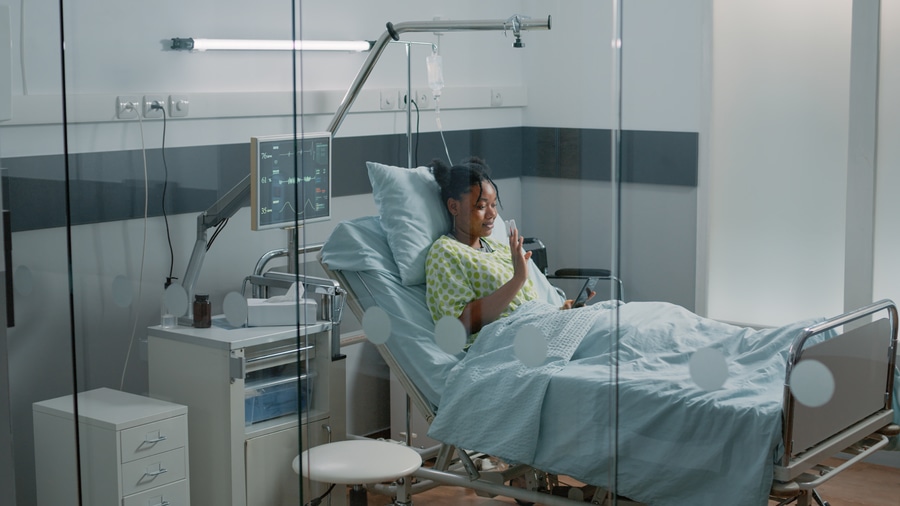
#Industry News
TECHNOLOGIES IN SMART HOSPITAL ROOMS AND HOW THEY'RE CHANGING HEALTHCARE
Using hospital beds for better patient care
With the help of smart rooms, hospitals can transform the patient experience by providing modern devices to make the patient's stay much more comfortable than in a traditional hospital room. While many aspects contribute to a fully integrated smart hospital room, the primary goal is to provide a more personal experience through implementing various technologies like patient infotainment.
Smart hospital rooms can decrease staff burden while helping reduce patient worry, pain, and anxiety. Patients in a hospital smart room have much greater control over their environment without staff assistance. Something as simple as replacing a whiteboard with a medical-grade monitor can make a significant difference.
Voice Control
There are numerous advantages to incorporating voice assistants in patient rooms. The units can be as basic as an Amazon Echo equipped with the Alexa voice command program. Many patients already use voice assistants at home, so having a familiar device can be a pleasant distraction. Patients can use these assistants to play music, listen to the news, or play games. Additionally, some patients may feel more at ease making requests via a voice assistant device, rather than in person.
Patients can get even more significant advantages from the presence of voice control. The environment can be adjusted in various ways without someone needing to get out of bed or call a nurse. Lights can be turned off, temperature lowered or raised, window coverings are drawn, and TV power, volume, or channels changed. If a patient has limited mobility, this significantly improves their quality of stay without the need for a nurse to help with these simple tasks.
Another benefit is that of clinical workflow improvements for staff. For example, voice commands can easily play content for newly admitted patients, educational content, or request help quickly.
Smart Hospital Beds
Recent technological advancements have significantly improved hospital beds, particularly in embedded control functions and interactivity. In the case of smart hospital beds, wireless sensors are now connected to pressure redistribution functions within the mattress to prevent bed sores. These smart mattresses can adjust their firmness to different areas, reducing the likelihood of patients becoming uncomfortable or developing sores.
In addition to pressure redistribution, smart hospital beds have several other features that make them more convenient and patient-friendly. For example, they often include USB ports for safe and easy device charging and storage compartments for nearby phones or medical tablets.
Digital Whiteboard
Whiteboards have long been used in patient rooms to display relevant but often changed information about patients or staff.
The latest improvement is a digital whiteboard screen that displays information clearly with interactive functions, so the need for markers or replacing whiteboards every few years is gone.
Digital whiteboards allow staff to display pertinent information and updates to communicate effectively. They can reduce the risk of medical errors by visually displaying patient medication schedules, discharge information, and pain scores.
Digital whiteboards in hospitals can help patients quickly access and remember the names of hospital staff, which can be useful in addressing any queries or concerns. This can ultimately lead to improved communication and engagement with patients and positively impact the Hospital Consumer Assessment of Healthcare Provider Scores. This national survey measures patients' perspectives on hospital care.
Connected App
Hospital room apps that patients can use from their smartphone or tablet have been shown to ease their worries and help already burdened staff.
Patients can look at their digital health chart, which includes information from their electronic health record, to get updates on the status of tests and their care. Thanks to the introduction of new technologies, this is just one example of a task that is no longer just in the hands of nurses.
Many hospital apps also allow patients to see aftercare and discharge instructions, play entertainment content, or even order food. The features, in this sense, are similar to what you would find on an airplane, but the greater level of amenities keeps patients at ease, and it can all be done without the direct help of a staff member.
Though some benefits may seem superficial, these simple things can add up and relieve the nurses' burden while making the patient's stay significantly more comfortable.
Closing Thoughts
Smart hospital rooms have made significant progress in the last 5-10 years by using consumer electronics in innovative ways and incorporating technology into traditional hospital equipment. These advancements have given patients more control over their environment, making their hospital stays more comfortable and reducing staff members' workload.
Discover the latest technologies in smart hospital rooms and how they revolutionize healthcare. Enhance patient comfort and personalization with modern devices. Contact an expert at Cybernet to learn more about how their products, like medical carts, medical-grade computers, tablets, and monitors, can make a hospital room smart, improving the quality of stay for patients and general staff workflow. With various customizable solutions and the knowledge to guide you in the right direction, you will be directed to an ideal solution.







